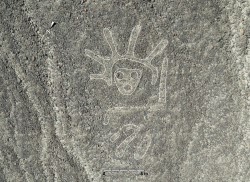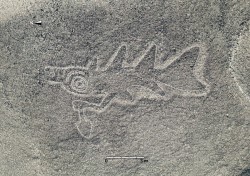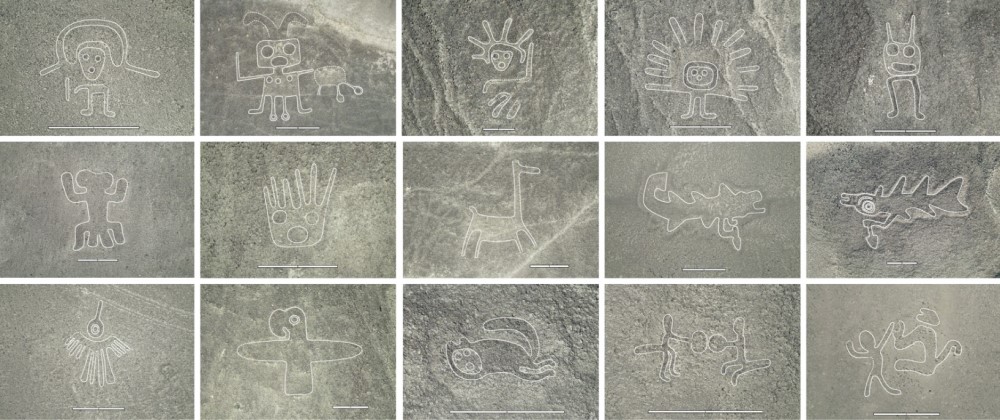Revolutionary discovery at Nazca: more than 300 new geoglyphs revealed
The Nazca lines in Peru, already world-famous for their mysterious figures traced in the desert soil, have just revealed 303 new geoglyphs, thanks to advances in artificial intelligence technology. This major discovery, orchestrated by a team of researchers from Yamagata University in Japan, enriches our understanding of these enigmatic creations and opens up new clues about the civilisations that shaped them.
A Desert of Mysteries Unveiled
Located in the arid Nazca desert, these lines, which can only be seen in their entirety from the sky, have long intrigued researchers and the curious. The new geoglyphs, varying in complexity and representation from simple lines to more elaborate figures such as animals or human forms, add another layer to the historical enigma of their purpose and meaning.
AI Technology to the rescue
 Recent advances in artificial intelligence have made these discoveries possible. Algorithms specifically designed to analyse the slightest variations in ground relief have made it possible to detect shapes that are indiscernible to the naked eye or using traditional methods. This non-invasive method also ensures that the site remains intact, vital for future studies and heritage conservation.
Recent advances in artificial intelligence have made these discoveries possible. Algorithms specifically designed to analyse the slightest variations in ground relief have made it possible to detect shapes that are indiscernible to the naked eye or using traditional methods. This non-invasive method also ensures that the site remains intact, vital for future studies and heritage conservation.
Archaeological and historical implications
Experts suggest that these new geoglyphs could date back to 500 BC, attributed to the Nazca culture, renowned for its ceramics, textiles and, of course, its geoglyphic lines. The study of these forms could reveal hitherto unknown aspects of their cosmology, social practices and spatial organisation. The involvement of Yamagata University in Japan – through its Nazca Institute – in this discovery underlines the importance of international collaboration in archaeological research.
A World Heritage Treasure
The discovery of these new geoglyphs enriches not only Peru’s cultural heritage, but also that of the world. It draws attention to the need to protect these sites from threats such as erosion, vandalism and the impacts of climate change.
Towards new discoveries
This recent discovery opens the door to future research and hypotheses on the significance of the Nazca Lines. With AI as a key tool, archaeologists and scientists are optimistic about the discovery of new sites, estimated at more than 1,000 as yet unknown geoglyphs, offering new keys to understanding the ancient civilisations of Peru.
Tourism in Nazca, an ongoing exploration
 The discovery of these geoglyphs is a tremendous boost to tourism in the Nazca region. By regularly revealing new motifs, these discoveries maintain interest and stimulate a dynamic of recurring visits. Visitors, already captivated by the ancient mysteries, now have additional reasons to return, attracted by the promise of new discoveries on every visit.
The discovery of these geoglyphs is a tremendous boost to tourism in the Nazca region. By regularly revealing new motifs, these discoveries maintain interest and stimulate a dynamic of recurring visits. Visitors, already captivated by the ancient mysteries, now have additional reasons to return, attracted by the promise of new discoveries on every visit.
This prospect not only enriches the tourist experience but also ensures a constant flow of visitors, making a significant contribution to the local economy. The authorities, in collaboration with researchers and tour guides, can now plan updated exhibitions and tours, ensuring that each visit offers a new and deeper perspective on the incredible stories etched into the Nazca desert.
Our article: The Nazca Lines: a Peruvian enigma
The new discoveries at Nazca not only deepen our understanding of the ancient peoples of Peru but also remind us of the need to preserve these precious sites for future generations. With the help of cutting-edge technology, the secrets of Nazca continue to unfold, promising even more revelations about the cultures that once inhabited these mysterious lands.
Photos: Yamagata University Institute of Nasca
RECENT POSTS

122nd UN Tourism Executive Council: Innovation, Investment and Education at the Heart of Discussions
LATAM NEWS 122nd UN Tourism Executive Council: Innovation, Investment and Education at the Heart of Discussions The 122nd edition of the UN Tourism Executive Council was held in Cartagena de Indias, Colombia, with the aim of ensuring a more inclusive, resilient and...

“From the Great Wall to Machu Picchu”: A Documentary to Strengthen Tourism Links between China and Peru
LATAM NEWS “From the Great Wall to Machu Picchu": A Documentary to Strengthen Tourism Links between China and Peru To strengthen cultural exchanges and attract Chinese travellers to Peru, PROMPERÚ has collaborated on an ambitious audiovisual project: the documentary...

Best Tourism Villages 2024: an award for excellence in rural tourism
LATAM NEWS Best Tourism Villages 2024: an award for excellence in rural tourismEvery year, UN Tourism celebrates rural destinations that embody sustainable and inclusive tourism through its Best Tourism Villages initiative. The 2024 edition once again highlighted...



